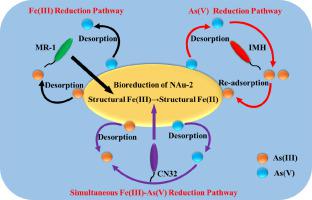Science of the Total Environment ( IF 8.2 ) Pub Date : 2020-12-25 , DOI: 10.1016/j.scitotenv.2020.144613 Ziwang Zhao , Ying Meng , Qingke Yuan , Yahua Wang , Leiming Lin , Wenbin Liu , Fubo Luan

|
Clay minerals are an important host for arsenic in many arsenic-affected areas. The role of bioreduction of structural Fe(III) in clay minerals in the mobilization of arsenic from clay minerals, however, still remains unclear. In this study, Fe(III) reducing bacterium, As(V) reducing bacterium, and Fe(III)-As(V) reducing bacterium were employed to investigate the possible bioreduction pathways for arsenic release from Nontronite NAu-2. Results demonstrated that microbial reduction controlled arsenic mobilization from NAu-2 through Fe(III), As(V), and simultaneous Fe(III)-As(V) reduction pathways. Although the bioreduction of structural Fe(III) led to a negligible dissolution of NAu-2, it triggered a significant release of arsenic from NAu-2. The bioreduction of tetrahedral Fe(III) initiated the release of As(V), and the further bioreduction of octahedral Fe(III) induced the release of As(III) in NAu-2. In addition, bioreduction of As(V) resulted in the desorption and transformation of As(V) from NAu-2. Simultaneous bioreduction of Fe(III) and As(V) led to an almost complete release of As(V) from NAu-2. These findings suggest that simultaneous Fe(III)-As(V) reduction was the dominant pathway governing As(V) release from NAu-2, while structural Fe(III) reduction controlled As(III) release from NAu-2. Therefore, the bioreduction of iron-bearing clay minerals has a great potential for arsenic mobilization in the subsurface environment.
中文翻译:

通过含铁,砷和同时还原铁-砷的途径从含铁粘土矿物中微生物迁移砷
在许多受砷影响的地区,粘土矿物质是砷的重要宿主。然而,在粘土矿物质中生物还原结构性Fe(III)在从粘土矿物质中迁移砷中的作用仍不清楚。在这项研究中,Fe(III)还原细菌,As(V)还原细菌和Fe(III)-As(V)还原细菌用于研究从绿脱石NAu-2释放砷的可能的生物还原途径。结果表明,微生物还原控制砷从NAu-2通过Fe(III),As(V)和同时的Fe(III)-As(V)还原途径的迁移。尽管结构性Fe(III)的生物还原导致NAu-2的溶解可忽略不计,但它触发了从NAu-2大量释放砷。四面体Fe(III)的生物还原引发了As(V)的释放,八面体Fe(III)的进一步生物还原诱导了NAu-2中As(III)的释放。此外,As(V)的生物还原导致NAu-2从As(V)解吸和转化。Fe(III)和As(V)的同时生物还原导致从NAu-2几乎完全释放出As(V)。这些发现表明Fe(III)-As(V)的同时还原是控制NAu-2释放As(V)的主要途径,而结构化Fe(III)还原则控制了NAu-2释放As(III)。因此,含铁粘土矿物的生物还原具有在地下环境中动员砷的巨大潜力。Fe(III)和As(V)的同时生物还原导致从NAu-2几乎完全释放出As(V)。这些发现表明Fe(III)-As(V)的同时还原是控制NAu-2释放As(V)的主要途径,而结构化Fe(III)还原则控制了NAu-2释放As(III)。因此,含铁粘土矿物的生物还原具有在地下环境中动员砷的巨大潜力。Fe(III)和As(V)的同时生物还原导致从NAu-2几乎完全释放出As(V)。这些发现表明Fe(III)-As(V)的同时还原是控制NAu-2释放As(V)的主要途径,而结构化Fe(III)还原则控制了NAu-2释放As(III)。因此,含铁粘土矿物的生物还原具有在地下环境中动员砷的巨大潜力。































 京公网安备 11010802027423号
京公网安备 11010802027423号